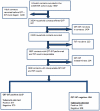Risk factors associated with positive QuantiFERON-TB Gold In-Tube and tuberculin skin tests results in Zambia and South Africa
- PMID: 21483746
- PMCID: PMC3070723
- DOI: 10.1371/journal.pone.0018206
Risk factors associated with positive QuantiFERON-TB Gold In-Tube and tuberculin skin tests results in Zambia and South Africa
Abstract
Introduction: The utility of T-cell based interferon-gamma release assays for the diagnosis of latent tuberculosis infection remains unclear in settings with a high burden of tuberculosis.
Objectives: To determine risk factors associated with positive QuantiFERON-TB Gold In-Tube (QFT-GIT) and tuberculin skin test (TST) results and the level of agreement between the tests; to explore the hypotheses that positivity in QFT-GIT is more related to recent infection and less affected by HIV than the TST.
Methods: Adult household contacts of tuberculosis patients were invited to participate in a cross-sectional study across 24 communities in Zambia and South Africa. HIV, QFT-GIT and TST tests were done. A questionnaire was used to assess risk factors.
Results: A total of 2,220 contacts were seen. 1,803 individuals had interpretable results for both tests, 1,147 (63.6%) were QFT-GIT positive while 725 (40.2%) were TST positive. Agreement between the tests was low (kappa = 0.24). QFT-GIT and TST results were associated with increasing age (adjusted OR [aOR] for each 10 year increase for QFT-GIT 1.15; 95% CI: 1.06-1.25, and for TST aOR: 1.10; 95% CI 1.01-1.20). HIV positivity was less common among those with positive results on QFT-GIT (aOR: 0.51; 95% CI: 0.39-0.67) and TST (aOR: 0.61; 95% CI: 0.46-0.82). Smear positivity of the index case was associated with QFT-GIT (aOR: 1.25; 95% CI: 0.90-1.74) and TST (aOR: 1.39; 95% CI: 0.98-1.98) results. We found little evidence in our data to support our hypotheses.
Conclusion: QFT-GIT may not be more sensitive than the TST to detect risk factors associated with tuberculous infection. We found little evidence to support the hypotheses that positivity in QFT-GIT is more related to recent infection and less affected by HIV than the TST.
Conflict of interest statement
Figures



Similar articles
-
Prevalence of latent tuberculosis infection in persons with and without human immunodeficiency virus infection using two interferon-gamma release assays and tuberculin skin test in a low human immunodeficiency virus prevalence, intermediate tuberculosis-burden country.J Microbiol Immunol Infect. 2016 Oct;49(5):729-736. doi: 10.1016/j.jmii.2014.08.010. Epub 2014 Nov 1. J Microbiol Immunol Infect. 2016. PMID: 25442858
-
Tuberculin skin test and QuantiFERON-Gold In Tube assay for diagnosis of latent TB infection among household contacts of pulmonary TB patients in high TB burden setting.PLoS One. 2018 Aug 1;13(8):e0199360. doi: 10.1371/journal.pone.0199360. eCollection 2018. PLoS One. 2018. PMID: 30067752 Free PMC article.
-
Predictors of discordant tuberculin skin test and QuantiFERON®-TB Gold In-Tube results in various high-risk groups.Int J Tuberc Lung Dis. 2011 Aug;15(8):1056-61. doi: 10.5588/ijtld.10.0650. Int J Tuberc Lung Dis. 2011. PMID: 21740668
-
Comparing the diagnostic performance of QuantiFERON-TB Gold Plus with QFT-GIT, T-SPOT.TB and TST: a systematic review and meta-analysis.BMC Infect Dis. 2023 Jan 20;23(1):40. doi: 10.1186/s12879-023-08008-2. BMC Infect Dis. 2023. PMID: 36670347 Free PMC article.
-
Systemic review: agreement between the latent tuberculosis screening tests among patients with rheumatic diseases.Korean J Intern Med. 2018 Nov;33(6):1241-1251. doi: 10.3904/kjim.2016.222. Epub 2017 Dec 28. Korean J Intern Med. 2018. PMID: 29277097 Free PMC article.
Cited by
-
Two-step tuberculin skin testing in school-going adolescents with initial 0-4 millimeter responses in a high tuberculosis prevalence setting in South India.PLoS One. 2013 Sep 6;8(9):e71470. doi: 10.1371/journal.pone.0071470. eCollection 2013. PLoS One. 2013. PMID: 24039716 Free PMC article.
-
Community-based evaluation of immigrant tuberculosis screening using interferon γ release assays and tuberculin skin testing: observational study and economic analysis.Thorax. 2013 Mar;68(3):230-9. doi: 10.1136/thoraxjnl-2011-201542. Epub 2012 Jun 12. Thorax. 2013. PMID: 22693179 Free PMC article.
-
A score to predict and stratify risk of tuberculosis in adult contacts of tuberculosis index cases: a prospective derivation and external validation cohort study.Lancet Infect Dis. 2017 Nov;17(11):1190-1199. doi: 10.1016/S1473-3099(17)30447-4. Epub 2017 Aug 18. Lancet Infect Dis. 2017. PMID: 28827142 Free PMC article.
-
Tuberculosis Infection in Women of Reproductive Age: A Cross-sectional Study at Antenatal Care Clinics in an Ethiopian City.Clin Infect Dis. 2021 Jul 15;73(2):203-210. doi: 10.1093/cid/ciaa561. Clin Infect Dis. 2021. PMID: 32412638 Free PMC article.
-
Incident Tuberculosis Infection Is Associated With Alcohol Use in Adults in Rural Uganda.Clin Infect Dis. 2025 Mar 17;80(3):562-565. doi: 10.1093/cid/ciae304. Clin Infect Dis. 2025. PMID: 38824440 Free PMC article.
References
-
- Dye C, Watt CJ, Bleed DM, Hosseini SM, Raviglione MC. Evolution of Tuberculosis Control and Prospects for Reducing Tuberculosis Incidence, Prevalence, and Deaths Globally. JAMA. 2005;293:2767–2775. - PubMed
-
- Daley CL, Small PM, Schecter GF, Schoolnik GK, McAdam RA, et al. An Outbreak of Tuberculosis with Accelerated Progression among Persons Infected with the Human Immunodeficiency Virus. New England Journal of Medicine. 1992;326:231–235. - PubMed
-
- Guelar A, Gatell JM, Verdejo J, Podzamczer D, Lozano L, et al. A prospective study of the risk of tuberculosis among HIV-infected patients. Aids. 1993;7:1345–1349. - PubMed
-
- Centers for Disease Control and Prevention. Targeted tuberculin testing and treatment of latent tuberculosis infection. MMWR. 2000;49(No. RR-6)) - PubMed
-
- World Health Organization, Department of HIV/AIDS, Stop TB Department. Guidelines for intensified tuberculosis case finding and isoniazid preventive therapy for people living with HIV in resource constrained settings. 2011.
Publication types
MeSH terms
Substances
Grants and funding
LinkOut - more resources
Full Text Sources

